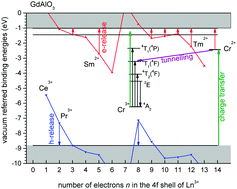The dual role of Cr3+ in trapping holes and electrons in lanthanide co-doped GdAlO3 and LaAlO3
Abstract
Trivalent Nd, Dy, Ho, Er, Tm, Sm and Eu usually act as electron trapping centers in wide band gap compounds, whereas trivalent Ce, Tb and Pr act as hole trapping centers. When a deep electron trap is combined with a shallow hole trap, then during the thermoluminescence glow the hole is released, generating recombination luminescence at the electron trap. However, in the case of a shallow electron trap, the electron will be released to recombine at the hole trapping center. With the knowledge of the location of the lanthanide levels within the band gap, one may engineer the depth of the electron trap, the depth of the hole trap, and where the recombination will take place. This has all been tested and verified for the lanthanides in GdAlO3 (Luo et al., J. Phys. Chem. C., 2016, 120, 5916). In this work, Cr3+ is combined with various trivalent lanthanides in GdAlO3. By combining thermoluminescence with optical spectroscopy data, a consistent interpretation of all the data is obtained. Cr3+ can act both as a deep electron trap and a deep hole trap, which is different to all of the lanthanides. From the results we can deduce the location of the Cr2+ and Cr3+ levels within the band gap and with respect to the vacuum level. Besides thermoluminescence recombination via the conduction band, evidence is found for athermal (tunneling) recombination. The results for GdAlO3 are compared with the results for LaAlO3. It was found that they are related systems but LaAlO3 has a lower lying conduction band and a higher lying valence band, which reduces the trap depths of the lanthanides and Cr in a predictive fashion.



 Please wait while we load your content...
Please wait while we load your content...